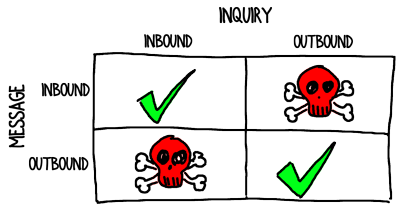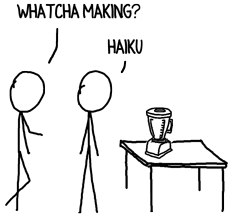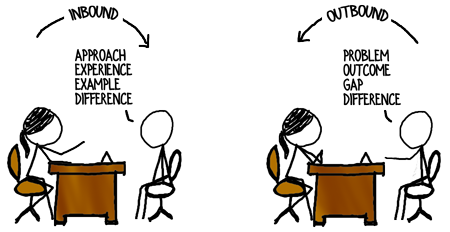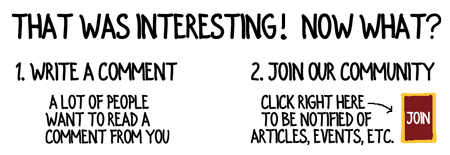Inbound vs. Outbound Messages. The Critical Difference That Trips Up Consultants
In the past week I’ve reviewed four presentations from consultants who want me to recommend their offering to my corporate clients. Not one of them made the grade. Why? They used Inbound messages for an Outbound inquiry. If you’re a consultant, you need to know the difference.

When your message and the direction of inquiry aren’t in sync, the fallout extends beyond the immediate conversation. You also damage your chances of winning business from that prospect in the future.
Inbound Inquiry: The client approaches you in search of a solution.
Picture Benedict Cumberbatch standing at the shelf in Barnes & Noble, pondering the vast array of books about how to coax his new baby to sleep. He’s seeking a solution. His questions are: Which of these books is best, what approach seems most credible, why should he believe this author, and which book validates his belief that most child-rearing issues can be solved with duct tape.
Outbound Inquiry: You approach the client in search of an opportunity.
Now imagine Benedict lounging in front of the TV when an infomercial for Instant Poetry Magic comes on. The enthusiastic presenter has a solution and is hoping Benedict’s a buyer. Benedict’s questions are: Why would he need Instant Poetry? How will it improve his life? Can’t he just use his old thesaurus and a blender?

The litmus test to differentiate between Inbound and Outbound inquiries is simple: Who initiated the conversation?
Alas, most consultants’ presentations, like the four I recently reviewed, are loaded with information that doesn’t fit the direction of inquiry.
The first conversation with a new prospect should always start with an effort to understand the prospect’s situation. However, once you progress to the part of that conversation when you’re talking about you, your message has to reflect the direction of the inquiry. Here’s the difference:
Your Inbound message should consist of, in order:
- Your approach and/or process
- Your experience and expertise (industry experience, in particular)
- Case studies/examples of your success
- What makes you/your approach the best solution
Your Outbound message should consist of, in order:
- The precise problem you solve, phrased in the client’s language.
- The valuable outcome of your work together
- Why they need an outsider to achieve that outcome
- What makes you/your approach the best solution

Notice there’s very little overlap between Inbound and Outbound messages. The presentations I received from consultants were chock full of processes and approaches. Models galore. An Inbound extravaganza. Even though they expected me to present their ideas, unsolicited, to prospective clients; i.e., an Outbound inquiry.
When the message and direction of inquiry is mismatched, the prospect feels like you’re wasting their time. You’re either reminding them of their problem (they already know that) or you’re talking solutions before fully hearing their issues.
Get your messages straight. Have a credentials deck prepared for those delightful, Inbound inquiries when they occur. And set that deck totally aside for your Outbound efforts. When it comes to your Outbound message, remember the focus needs to be on Them not on You.
What can you do to improve your message to prospects?

Text and images are © 2024 David A. Fields, all rights reserved.

 David A. Fields Consulting Group
David A. Fields Consulting Group 
Brilliant per usual. A small difference but a big impact.
Thank you, Gayle. I know that in your work with women 50+ you do the exact same thing: suggest small changes that can have a big impact. That’s a theme many consultants can adopt to be successful.
The difference between these two messages is as big as the difference between speaking and listening.
Great advice just in time as I’m working on my outbound materials. Many thanks.
You’re welcome, Laurie. You also hit the nail on the head: speaking vs. listening, when to employ each to maximum effect, and how to do each well are areas of continuous improvement for every consultant who aspires for a better practice.
Great distinctions. Again, it comes down to who you are trying to reach and with what kind of message. Thanks.
You’re welcome Jennifer. As you said, it comes down to who you are trying to reach. Also important: who’s doing the reaching. That’s what distinguishes Inbound from Outbound inquiries.
David,
What should a website be? Inbound? Outbound? or both?
Paveen, that is a GREAT question. Thank you for asking. Websites should be a veneer of Outbound with a solid core of Inbound. Prospects who look at your website fall into two buckets: 1) they’ve decided they have a problem (or aspiration) that’s probably worth addressing, but they’re not completely convinced; 2) They’ve decided they want to solve their problem and want to know if you’re the solution.
Unfortunately, a lot of prospects are still “kicking tires,” which puts them in the first bucket. For those visitors we need a bit of Outbound messaging: Problem, Outcome, Benefit.
However, since they’re already part way convinced they need to solve the problem, and the bucket #2 people are already convinced, the core of the website does need to have an Inbound focus: Approach, Experience, Proof.
Make sense?
David,
it would be helpful to see some examples of effective inbound and outbound messages.
That’s a fair request. This overview of the Firm Growth Lab is an example of Inbound messages. Consulting firms have typically already found me before they see this document, hence, it has a lot of process information. Since I don’t do a lot of Outbound marketing anymore, I had to dig into the archives to find an example. Here’s a one-pager that I think I used to include with a copy of my book when I was the one setting the meeting.